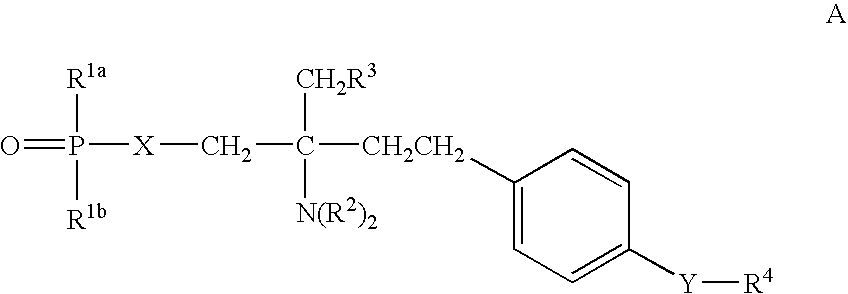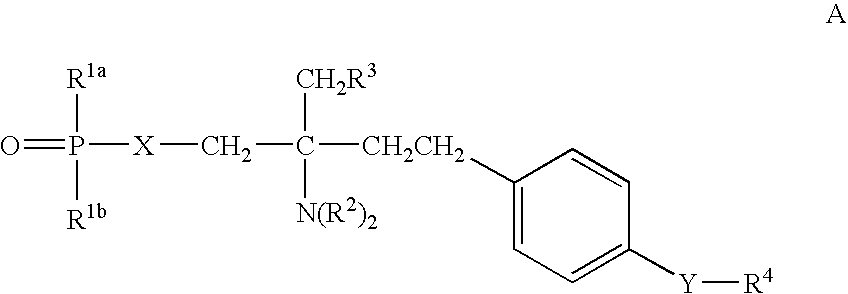Selective s1p1/edg1 receptor agonists
a s1p1/edg1 receptor and selective technology, applied in the field of compounds, can solve the problems of gastrointestinal discomfort, nephrotoxicity, neurotoxicity, and unsatisfactory side effects
- Summary
- Abstract
- Description
- Claims
- Application Information
AI Technical Summary
Benefits of technology
Problems solved by technology
Method used
Image
Examples
examples i -
Examples I-LVIII have the following structures:
Example No.StructureIIIIIIIVV + VIVIIVIIIIXXXIXIIXIIIXIVXV + XVIXVIIXVIIIXIXXXXXIXXIIXXIIIXXIVXXVXXVIXXVIIXXVIIIXXIXXXXXXXIXXXIIXXXIIIXXXVXXXVIXXXVIIXXXVIIIXXXIXXLXLIXLIIXLIIIXLIVXLVXLVIXLVIIXLVIIIXLIXLLILIILIIILIVLVLVILVIILVIII
General
Concentration of solutions was carried out on a rotary evaporator under reduced pressure. Conventional flash chromatography was carried out on silica gel (230-400 mesh). Flash chromatography was also carried out using a Biotage Flash Chromatography apparatus (Dyax Corp.) on silica gel (32-63 mM, 60 Å pore size) in pre-packed cartridges of the size noted. NMR spectra were obtained in CDCl3 solution unless otherwise noted. Coupling constants (J) are in hertz (Hz). Abbreviations: diethyl ether (ether), triethylamine (TEA), N,N-diisopropylethylamine (DIEA) sat'd aqueous (sat'd), rt (rt), hour(s) (h), minute(s) (min).
HPLC Conditions
LC-1: Waters Xterra MS C18, 5μ, 4.6×50 mm column, 10:90 to 95:5 v / v CH3CN / H...
example i
(R / S)-1-(4-(Nonyl)phenyl)methyl-3-hydroxy-pyrrolidin-3-yl)phosphonic Acid
Step A: (RES)-1-tert-Butoxycarbonyl-3-hydroxypyrrolidine
A solution of 2.5 g (28.7 mmol) of (R / S)-3-hydroxypyrrolidine in 10 mL of CH2Cl2 at 0° C. was treated with 6.89 g (31.6 mmol) of di-tert-butyl-dicarbonate in 2 mL CH2Cl2 and 0.35 g (2.8 mmol) of 4-(N,N-dimethylamino) pyridine. After stirring for 10 min, the reaction was warmed to rt and stirred overnight. The reaction was diluted with 100 mL of CH2Cl2 and washed with 100 mL of 1N HCl and 100 mL of 1N NaHCO3. The organic layer was dried over Na2SO4 and concentrated. The residue was purified on a 40M Biotage column using 7:3 v / v hexane / acetone as the eluant to afford 5.3 g (99%) of the title compound: RF: 0.26 (7:3 v / v hexane / acetone); 1H-NMR (500 MHz) δ 1.45 (s, 9H), 1.88-2.00 (m, 2H), 2.52 (br s, 1H), 3.29-3.50 (m, 4H), 4.42 (m, 1H).
Step B: 1-tert-Butoxycarbonyl-3-oxo-pyrrolidine
A solution of 2.3 mL (26 mmol) of oxalyl chloride in 80 mL of CH2Cl2 at ...
examples ii -
Examples II-X
EXAMPLES II-X were prepared using procedures analogous to those described in EXAMPLE I substituting the appropriate Aldehyde in Step E. TMS-Br was substituted in Step F with substrates containing TMS-I sensitive functionality (See EXAMPLE 11, Step D). In EXAMPLES V and VI enantiomers were resolved after Step E by preparative chiral HPLC (Chiralpak AD 2×25 cm HPLC column, 9:1 v / v hexane / EtOH, flow rate=9.0 mL / min, λ=210 nM).
HPLC RTESI-MSEXAMPLE #RHPLC Method(min)(M + H)IILC-12.7386IIILC-12.7386IVLC-13.0496V Enantiomer 1LC-12.84301H-NMR(500MHz, CD3OD) δ0.92(t, J=7.0, 3H), 1.20-1.54(m, 9H), 1.79-1.84(m, 2H), 2.23(m, 1H), 2.35(m, 1H), 2.43(m, 1H), 2.68(m, 1H), 3.41-3.50(m, 2H),3.58(m, 1H), 3.68(m, 1H), 3.75-3.79(m, 2H), 4.04(t, J=6.4, 2H), 4.11-4.15 (m,2H), 4.38(ABq, J=12.9, 2H), 7.02-7.09(m, 2H), 7.17(s, 1H)VI Enantiomer 2LC-12.8430VIILC-13.15441H-NMR(500MHz, CD3OD) δ0.93(t, J=6.8, 3H), 1.20-1.46(m, 9H), 1.55-1.61(m, 2H), 1.86-1.92(m, 2H), 2.23-2.35(m, 2H), 2.72(m, 1H),...
PUM
| Property | Measurement | Unit |
|---|---|---|
| Mass | aaaaa | aaaaa |
| Molar density | aaaaa | aaaaa |
| Molar density | aaaaa | aaaaa |
Abstract
Description
Claims
Application Information
 Login to View More
Login to View More - R&D
- Intellectual Property
- Life Sciences
- Materials
- Tech Scout
- Unparalleled Data Quality
- Higher Quality Content
- 60% Fewer Hallucinations
Browse by: Latest US Patents, China's latest patents, Technical Efficacy Thesaurus, Application Domain, Technology Topic, Popular Technical Reports.
© 2025 PatSnap. All rights reserved.Legal|Privacy policy|Modern Slavery Act Transparency Statement|Sitemap|About US| Contact US: help@patsnap.com



